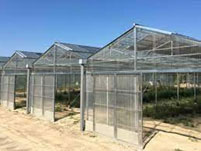Address
11 avenue Tom Morel 78210
Saint-Cyr-L'ecole

A greenhouse is a translucent structure promoting intensive agricultural production. With the development of the use of solar energy, the greenhouse takes on a new dimension. Today, photovoltaic greenhouses are becoming more and more successful due to their interest in the energy transition and the development of agricultural projects.
The greenhouse is an intensive production system used today in many regions of the world for the cultivation of certain vegetables, fruits, flowers or ornamental plants.
By protecting them from climatic hazards and making the most of natural solar radiation, the greenhouse allows crops to be placed in very favorable conditions, thus increasing yields and extending the production period. Photovoltaic greenhouse projects therefore consist of integrating photovoltaic modules into the structure of a greenhouse to produce electricity. In order to let light pass through, PV modules can be "semi-transparent": with crystalline cells allowing part of the light to pass between the cells, or with thin layers that are partly transparent.
Under a photovoltaic greenhouse, the impacts linked to climate change are controlled. Photovoltaic greenhouses also contribute to the ecological transition. They make the farmers who use them actors in renewable energies. The different advantages are:
The electricity produced by the photovoltaic plant is injected locally into the public distribution network.
A photovoltaic greenhouse project requires a significant investment. The cost of installing such a structure is obviously higher than that of a traditional greenhouse. This cost includes the price of the necessary materials and their implementation carried out by professionals.
AD POWER WATER, producer of renewable electricity, covers all or part of this cost and is remunerated from the sale of the electricity produced.
Photovoltaic agricultural greenhouses are suitable for a large number of crops. Market gardeners, horticulturists, nursery growers, but also wine growers will be able to cultivate many varieties of fruits and vegetables: peppers, spinach, zucchini, asparagus, kiwi, melon... Photovoltaic greenhouses are also perfect for the germination of mushrooms thanks to the darkening of the structure, but also for crops of orchids, hydrangeas, cyclamen, and much more.
AD POWER WATER installs solar panels on an agricultural greenhouse with a minimum surface area of 10,000 m2.